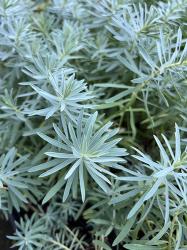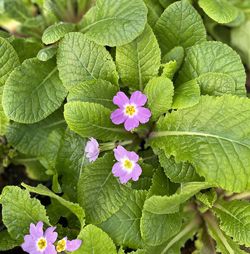
Euphorbia
Milkwort
Named after Euphorbus, physician to the king of Mauritania, this robust, sun-loving genus includes the familiar Poinsettia and is over 1600 species strong. Most Euphorbia have a poisonous milky sap and soft-colored bracts that surround subtly defined flowers. Autumn watches many of their narrow green leaves turn shades of red, orange and yellow.
Euphorbia ‘Copton Ash’ (P-1849)
Each 11.00

Honoring plantsman Kent Copton, who developed both a garden and a nursery in Faversham, England, this well-groomed shrubby Euphorbia produces finely hewn cool bluish green foliage and billowing masses of lime-green flowers in an endless summer procession. Compared to E. ‘Dean’s Hybrid’ or E. ‘Blue Haze’, its needle-like linear leaves are longer, while its larger semievergreen mound surpasses E. ‘Limewall’s. For a lovely floral pairing, ‘Copton Ash’ can be planted with Geranium sanguineum var. lancastriense along a pathway, amidst rock work or in a planter.
Blooms May–October
Size: 2' 0" high x 2' 0" wide.
Hardy to zone 7.
Please fill out our Registration Form to receive news of updates to the web site, availability of new plants, give us your feedback, and to be on the mailing list to receive future printed catalogs.
Other selections in this genus:
- Euphorbia ‘Acid Wash’
- Euphorbia amygaloides ‘Ruby Glow’
- Euphorbia ‘Blackbird’
- Euphorbia ‘Blue Haze’
- Euphorbia ‘Canyon Gold’
- Euphorbia characias ssp. wulfenii
- Euphorbia characias ‘Bruce’s Dwarf’
- Euphorbia characias ssp. wulfenii ssp. wulfenii ‘John Tomlinson’
- Euphorbia characias ssp. wulfenii ‘Lambrook Gold’
- Euphorbia characias ‘Red Wing’
- Euphorbia ‘Dean’s Hybrid’
- Euphorbia donii (Dixter Form)
- Euphorbia ‘Excalibur’
- Euphorbia griffithii ‘Fern Cottage’
- Euphorbia griffithii ‘Fireglow’
- Euphorbia griffithii ‘Great Dixter’
- Euphorbia ‘Helen Robinson’
- Euphorbia ‘Jade Dragon’
- Euphorbia ‘Limewall’
- Euphorbia longifolia
- Euphorbia x martini
- Euphorbia mellifera
- Euphorbia myrsinites
- Euphorbia polychroma ‘Candy’
- Euphorbia rigida
- Euphorbia sikkimensis
 A printed copy of them will be available upon request.
A printed copy of them will be available upon request.










